Ignite Your Day: 5 Healthy Breakfast Recipes for Maximum Energy
Beginning your day with a nutritious meal is crucial for sustaining energy levels and enhancing concentration. Breakfast is frequently regarded as the most vital meal of the day, and this is backed by solid reasoning. In this article, we’ll explore five delicious and nutritious breakfast recipes: Zucchini Fritters, Veggie Omelette, Almond Butter Toast, Cottage Cheese Bowl, and Sweet Potato Hash. Each recipe is designed to be easy to prepare, packed with nutrients, and bursting with flavor, ensuring you kickstart your day on the right note.
Key Aspects of Healthy Breakfast Recipes
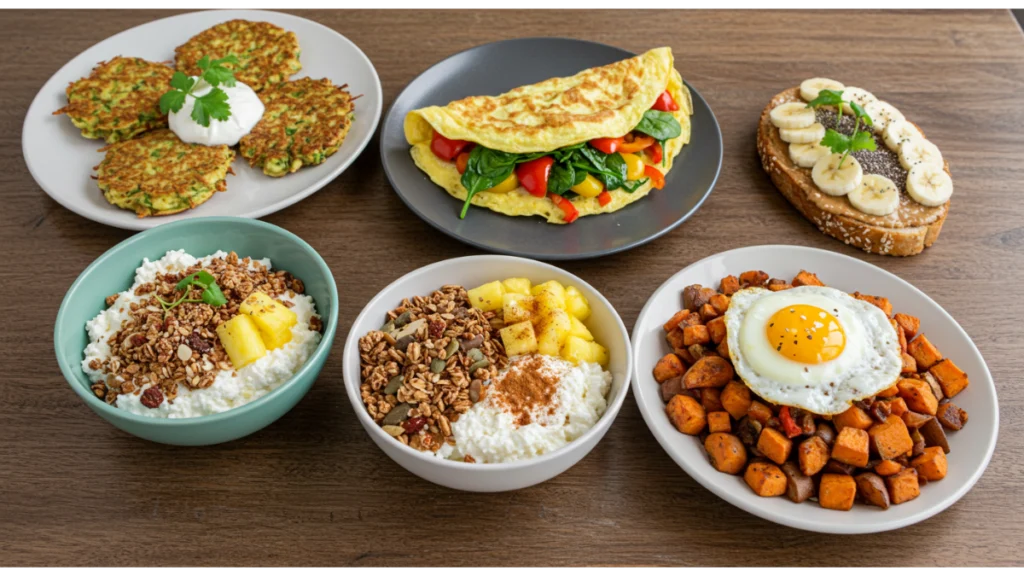
A nutritious breakfast is crucial for several reasons:
- Energy Boost: Breakfast provides the fuel your body needs after a night of fasting, helping to kickstart your metabolism. After sleeping for several hours, your body needs energy to function optimally. Eating breakfast replenishes your glucose levels, which is essential for brain function and energy production.
- Improved Concentration: Eating a balanced breakfast can enhance cognitive function, improving your focus and productivity throughout the day. Studies have shown that individuals who eat breakfast tend to perform better on tasks that require concentration and attention. The nutrients from breakfast help to improve memory and cognitive performance.
- Nutrient Intake: Breakfast allows you to incorporate essential nutrients into your diet, helping to meet daily requirements for vitamins and minerals. A well-rounded breakfast can help you achieve your daily intake of fiber, protein, vitamins, and minerals, which are vital for overall health.
- Weight Management: A healthy breakfast can help control hunger and prevent overeating later in the day. Skipping breakfast often leads to increased hunger later, which can result in unhealthy snacking or overeating at lunch. Eating a nutritious breakfast can help regulate appetite and support weight management goals.
- Better Mood: Consuming breakfast can improve your mood and reduce feelings of irritability. The nutrients in breakfast foods can have a positive effect on neurotransmitter function, which plays a role in mood regulation. A balanced breakfast can help stabilize blood sugar levels, preventing mood swings caused by hunger.
Ingredients You’ll Need for Healthy Breakfast Ideas
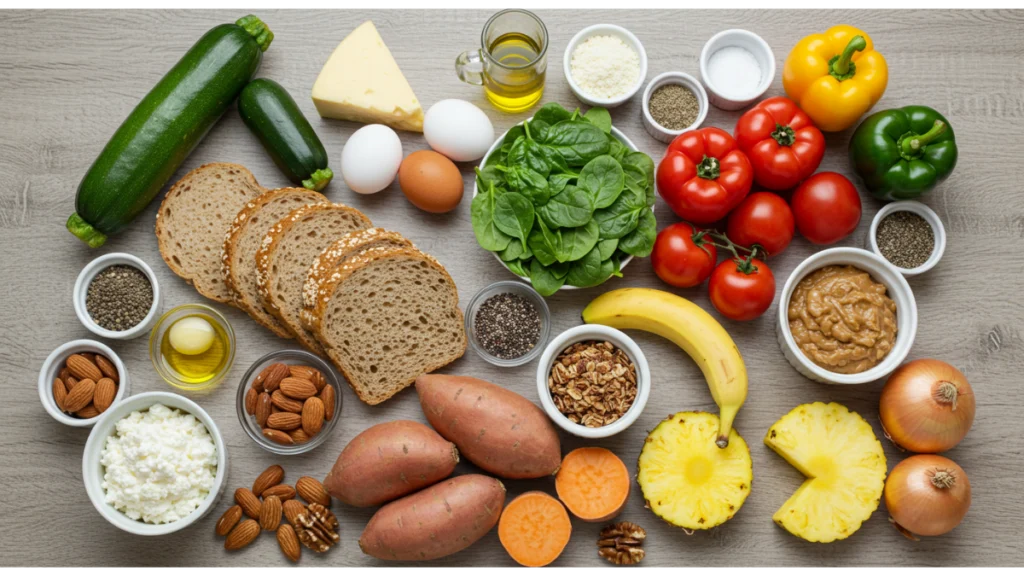
To prepare these five healthy breakfast recipes, you’ll need a variety of wholesome ingredients that are easy to find. Here’s a closer look at the key ingredients for each recipe:
- Zucchini Fritters: Zucchini, egg, flour (or almond flour), Parmesan cheese, garlic powder, olive oil, salt, and pepper. Zucchini is a versatile vegetable that is low in calories and high in moisture, making it perfect for fritters. The addition of flour and egg helps bind the fritters together, while Parmesan adds a savory flavor.
- Veggie Omelette: Eggs, bell peppers, spinach, tomatoes, olive oil or butter, salt, and pepper. Eggs provide an excellent source of protein along with beneficial fats. You can customize your omelette with any vegetables you have on hand, making it a great way to use up leftovers.
- Almond Butter Toast: Whole grain bread, almond butter, banana, chia seeds or flaxseeds, honey (optional). Whole grain bread provides fiber and complex carbohydrates, while almond butter offers healthy fats and protein. Topping it with banana adds natural sweetness and additional nutrients.
- Cottage Cheese Bowl: Cottage cheese, pineapple chunks (or any fruit), granola, cinnamon, nuts or seeds (optional). Cottage cheese is rich in protein and calcium, making it a filling base for a breakfast bowl. Adding fruit and granola enhances the flavor and provides additional vitamins and minerals.
- Sweet Potato Hash: Sweet potato, bell peppers, onion, olive oil, salt, and pepper, optional fried egg for topping. Sweet potatoes are a nutrient-dense source of carbohydrates, rich in vitamins A and C. Combining them with bell peppers and onions creates a colorful and flavorful dish.
Step-by-Step Instructions for Each Recipe
1. Zucchini Fritters

Zucchini fritters are a fantastic way to incorporate vegetables into your breakfast. They’re crispy on the outside, tender on the inside, and can be enjoyed plain or with a yogurt dip.
Instructions:
- Prepare the Zucchini: Grate 1 cup of zucchini and squeeze out excess moisture using a clean kitchen towel. This step is crucial for achieving crispy fritters.
- Mix the Ingredients: In a bowl, combine the grated zucchini, 1 large egg, 1/4 cup flour (or almond flour), 1/4 cup grated Parmesan cheese (optional), garlic powder, salt, and pepper. Mix until well combined.
- Heat the Oil: In a skillet, heat a tablespoon of olive oil over medium heat.
- Cook the Fritters: Drop spoonfuls of the zucchini mixture into the skillet, flattening them slightly. Sauté for approximately 3-4 minutes on each side until they achieve a golden-brown hue.
- Serve: Remove from the skillet and drain on paper towels. Serve warm, optionally with a dollop of Greek yogurt or sour cream.
Nutritional Information (per serving, makes about 4 fritters):
| Nutrient | Amount |
|---|---|
| Calories | 150 |
| Protein | 6g |
| Carbohydrates | 12g |
| Dietary Fiber | 2g |
| Sugars | 2g |
| Total Fat | 9g |
| Saturated Fat | 2g |
| Vitamin A | 20% DV |
| Vitamin C | 10% DV |
| Calcium | 8% DV |
Benefits: Zucchini is low in calories but high in vitamins A and C, making these fritters a nutritious way to start your day. The combination of protein from the egg and healthy fats from the olive oil makes this dish satisfying.
2. Veggie Omelette
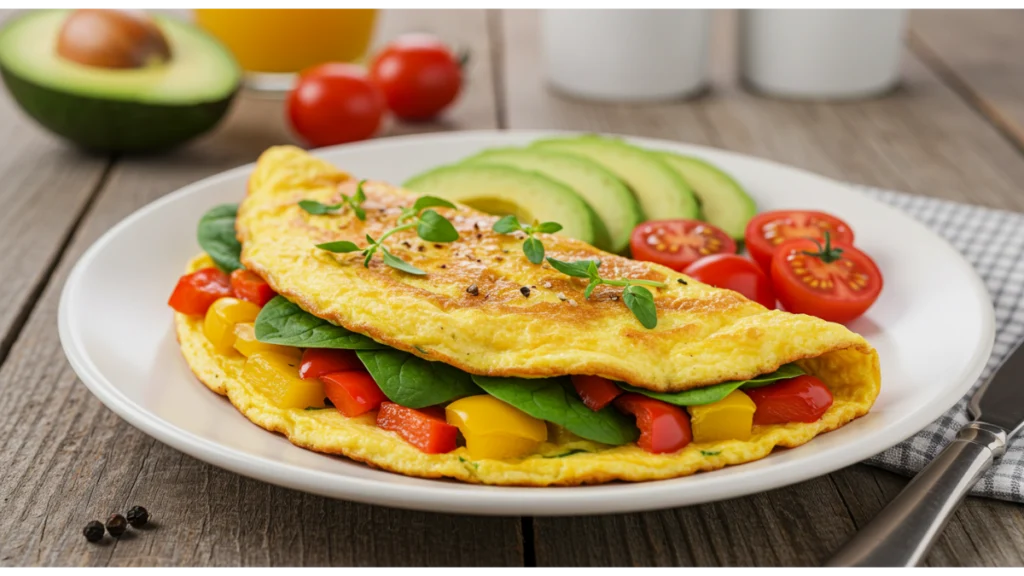
A veggie omelette is a classic breakfast choice that’s quick to prepare and packed with protein. You can customize it with your favorite vegetables and spices.
Instructions:
- Whisk the Eggs: In a bowl, whisk together 2 large eggs, salt, and pepper until well combined.
- Heat the Pan: In a non-stick skillet, heat a teaspoon of olive oil or butter over medium heat.
- Sauté the Vegetables: Add the bell peppers and spinach to the skillet, cooking until softened (about 2-3 minutes).
- Add the Eggs: Pour the whisked eggs over the sautéed vegetables. Cook for 2-3 minutes, gently lifting the edges with a spatula to allow uncooked eggs to flow to the edges.
- Fold and Serve: Once the eggs are set, fold the omelette in half and slide it onto a plate. Serve hot.
Nutritional Information (per serving, 2 eggs):
| Nutrient | Amount |
|---|---|
| Calories | 200 |
| Protein | 14g |
| Carbohydrates | 4g |
| Dietary Fiber | 1g |
| Sugars | 2g |
| Total Fat | 15g |
| Saturated Fat | 4g |
| Vitamin A | 30% DV |
| Vitamin C | 20% DV |
| Calcium | 6% DV |
Benefits: Eggs provide an excellent source of protein along with beneficial fats, while the vegetables add fiber and vitamins. This dish is also incredibly versatile—feel free to experiment with different vegetables or add cheese for extra flavor.
3. Almond Butter Toast
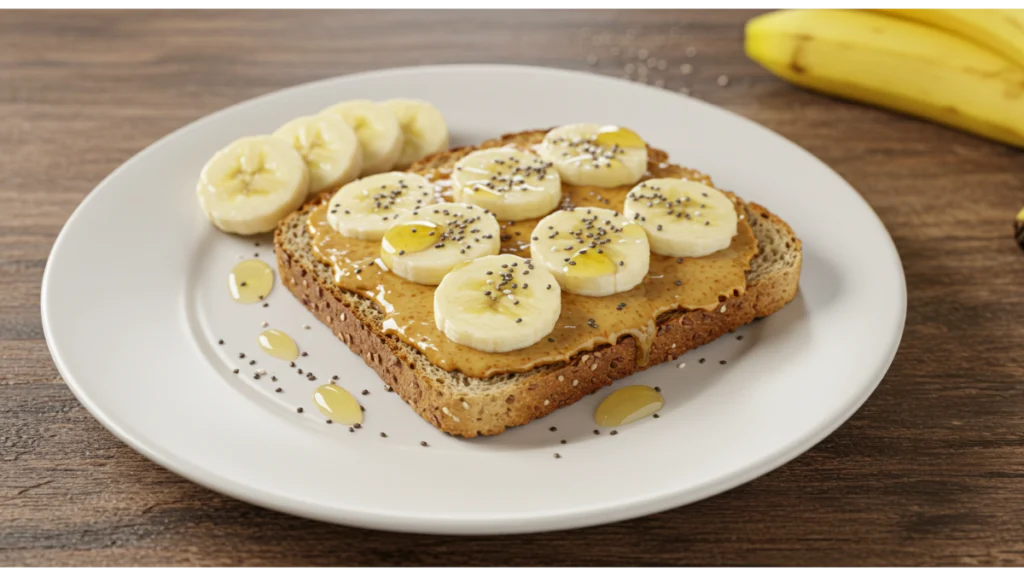
Almond butter toast is a simple yet satisfying breakfast that combines healthy fats and protein with the goodness of whole grains.
Instructions:
- Toast the Bread: Toast 1 slice of whole grain bread until golden brown.
- Spread Almond Butter: Once toasted, spread almond butter evenly over the slice.
- Add Toppings: Top with banana slices and sprinkle with chia seeds or flaxseeds. Drizzle with honey if desired.
- Serve: Cut in half and enjoy!
Nutritional Information (per serving, 1 slice of toast):
| Nutrient | Amount |
|---|---|
| Calories | 300 |
| Protein | 8g |
| Carbohydrates | 34g |
| Dietary Fiber | 5g |
| Sugars | 6g |
| Total Fat | 16g |
| Saturated Fat | 1g |
| Vitamin E | 15% DV |
| Magnesium | 10% DV |
| Potassium | 4% DV |
Benefits: Almond butter is rich in healthy fats, protein, and vitamin E, while whole grain bread provides fiber and sustained energy. This combination makes for a balanced breakfast that will keep you full until lunchtime.
4. Cottage Cheese Bowl
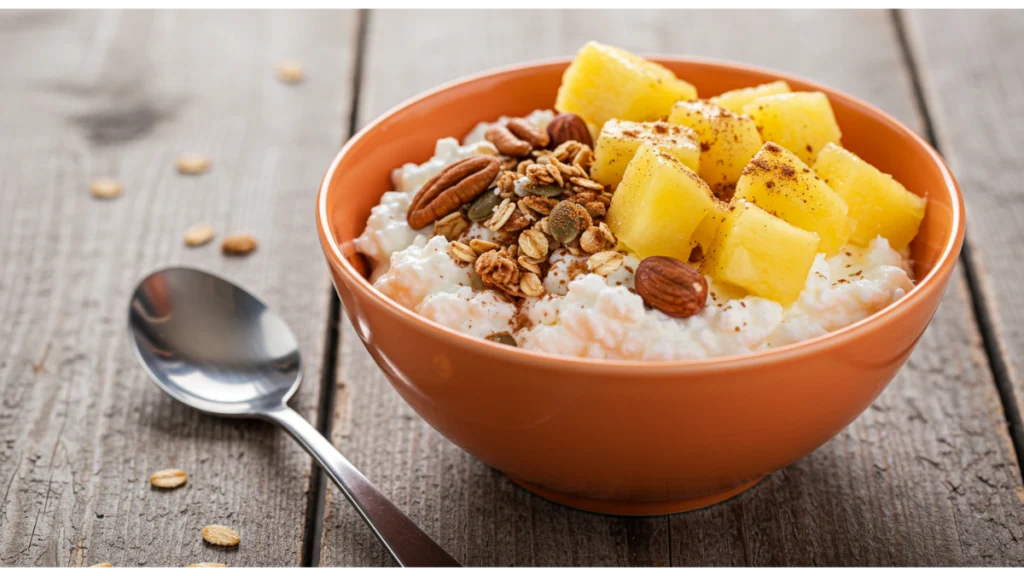
A cottage cheese bowl is a versatile breakfast option that can be sweet or savory, depending on your preference. It’s packed with protein and can be prepared in minutes.
Instructions:
- Combine Ingredients: In a bowl, add cottage cheese and top with pineapple chunks.
- Add Granola: Sprinkle granola on top for added texture.
- Season: If desired, add a sprinkle of cinnamon and some nuts or seeds.
- Serve: Enjoy immediately!
Nutritional Information (per serving, with 1 cup cottage cheese and 1/2 cup pineapple):
| Nutrient | Amount |
|---|---|
| Calories | 220 |
| Protein | 28g |
| Carbohydrates | 22g |
| Dietary Fiber | 2g |
| Sugars | 10g |
| Total Fat | 5g |
| Saturated Fat | 2g |
| Calcium | 30% DV |
| Vitamin D | 5% DV |
| Phosphorus | 20% DV |
Benefits: Cottage cheese is high in protein and calcium, making it a great choice for muscle maintenance and overall health. This dish is also easily customizable—try different fruits, nuts, or seeds to keep things interesting.
5. Sweet Potato Hash
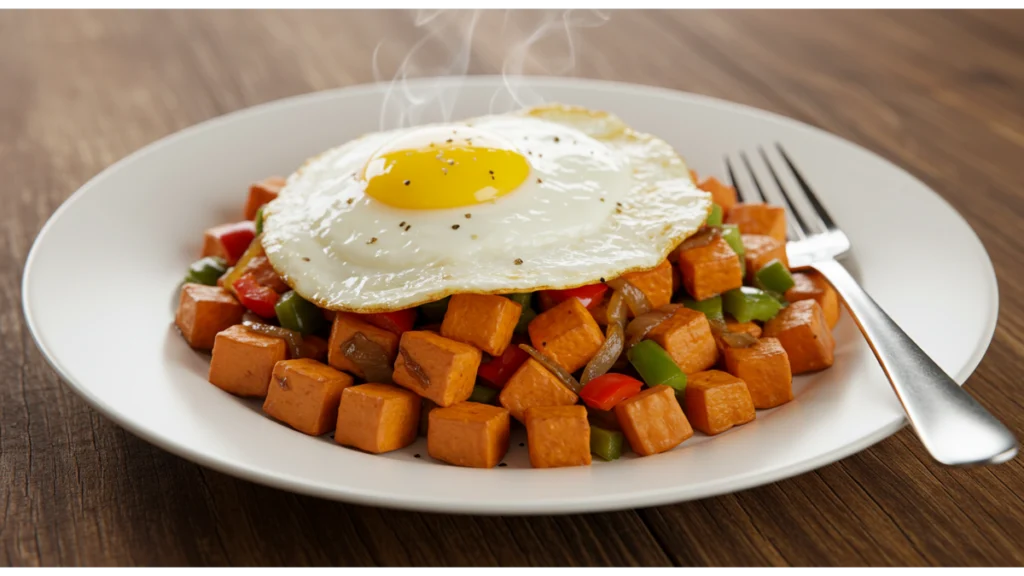
Sweet potato hash is a hearty and flavorful breakfast option that’s perfect for meal prep. It’s packed with nutrients and can be customized with various spices and toppings.
Instructions:
- Heat the Oil: In a skillet, heat a tablespoon of olive oil over medium heat.
- Cook the Sweet Potatoes: Add the diced sweet potato to the skillet and cook for about 5 minutes, stirring occasionally.
- Add the Vegetables: Once the sweet potatoes start to soften, add the bell peppers and onion. Continue cooking until all vegetables are tender and slightly caramelized (about 10 minutes).
- Season: Season with salt and pepper to taste.
- Serve: Serve warm, optionally topped with a fried egg.
Nutritional Information (per serving, with 1 medium sweet potato):
| Nutrient | Amount |
|---|---|
| Calories | 250 |
| Protein | 4g |
| Carbohydrates | 45g |
| Dietary Fiber | 7g |
| Sugars | 6g |
| Total Fat | 7g |
| Saturated Fat | 1g |
| Vitamin A | 300% DV |
| Vitamin C | 20% DV |
| Potassium | 10% DV |
Benefits: Sweet potatoes are rich in vitamins A and C, fiber, and antioxidants, making this dish a nutrient-dense breakfast choice. The combination of sweet potatoes and colorful vegetables adds a variety of flavors and textures.
Nutritional Value
| Recipe | Key Ingredients | Nutritional Benefits |
|---|---|---|
| Zucchini Fritters | Zucchini, egg, flour | Low in calories, high in vitamins A and C |
| Veggie Omelette | Eggs, spinach, peppers | High in protein, rich in vitamins and minerals |
| Almond Butter Toast | Whole grain bread, almond butter | Healthy fats, protein, fiber |
| Cottage Cheese Bowl | Cottage cheese, fruit | High in protein, calcium, and probiotics |
| Sweet Potato Hash | Sweet potato, bell peppers | Rich in vitamins A and C, fiber, and antioxidants |
Benefits of Each Recipe
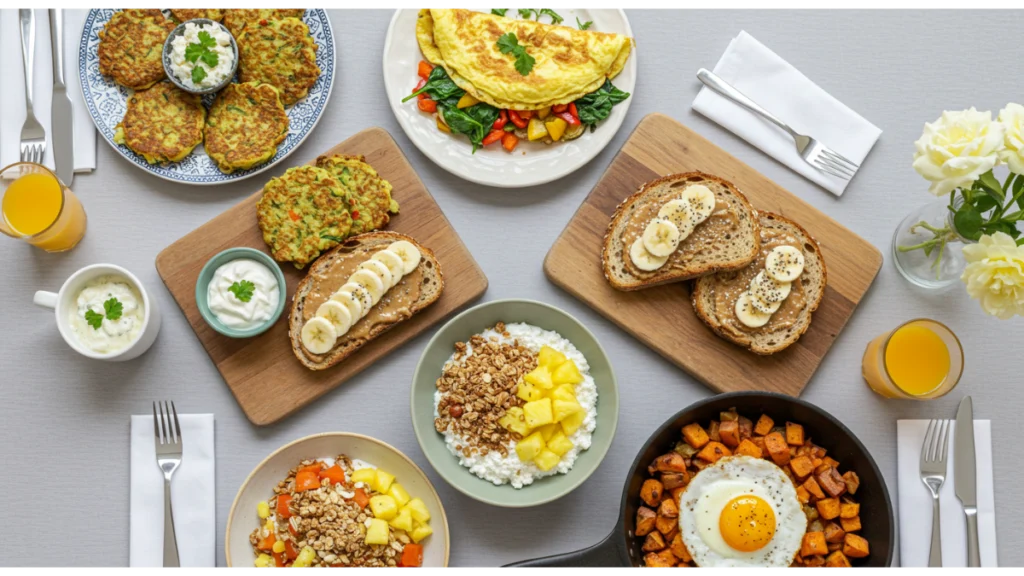
- Zucchini Fritters: A fantastic way to sneak in veggies while enjoying a crispy treat. They are low in carbs and high in vitamins, making them a nutritious start to the day.
- Veggie Omelette: Packed with protein and nutrients, this dish is versatile and can be customized to include your favorite vegetables. It’s a quick option that can easily be made ahead of time.
- Almond Butter Toast: A quick breakfast option that provides healthy fats, protein, and fiber, keeping you full longer. The combination of almond butter and banana adds a delicious flavor profile.
- Cottage Cheese Bowl: This bowl is high in protein and can be tailored to your taste with various fruits and toppings. It’s a great option for those looking for a light yet filling breakfast.
- Sweet Potato Hash: A hearty and filling option that is rich in complex carbohydrates and vitamins, perfect for a satisfying breakfast. It can be made in larger batches for meal prep.
Overcoming Challenges
Many people struggle with breakfast due to time constraints. Here are some practical tips to make breakfast preparation easier:
- Meal Prep: Prepare ingredients in advance. Chop vegetables or cook sweet potatoes ahead of time to save time in the morning. You can also batch-cook items like zucchini fritters or sweet potato hash and store them in the fridge for quick reheating.
- Quick Recipes: Choose recipes that require minimal cooking time, like the almond butter toast or cottage cheese bowl. These options can be assembled in just a few minutes.
- Use Leftovers: Incorporate leftovers from dinner into your breakfast, such as using roasted vegetables in your omelette or sweet potato hash. This approach not only conserves time but also minimizes food waste.
- Keep It Simple: Stick to simple recipes that have few ingredients, making it easier to whip up a nutritious meal quickly. Focus on recipes that highlight whole foods and minimal processing.
- Invest in Good Kitchen Tools: Having the right kitchen tools can make breakfast preparation quicker and easier. A good knife, cutting board, and non-stick skillet can significantly speed up the cooking process.
Future Trends
As health consciousness continues to grow, expect to see more emphasis on plant-based ingredients and functional foods in breakfast recipes. Here are some anticipated trends:
- Plant-Based Options: More people are shifting towards plant-based diets, leading to an increase in recipes featuring plant proteins and dairy alternatives. Expect to see more recipes using ingredients like tofu, chickpeas, and lentils in breakfast dishes.
- Functional Foods: Ingredients that offer health benefits, such as probiotics and superfoods, will become more popular in breakfast options. Foods like chia seeds, flaxseeds, and spirulina are likely to be incorporated into breakfast recipes for added nutritional value.
- Global Flavors: Expect to see breakfast recipes inspired by international cuisines, introducing new flavors and ingredients. Dishes like shakshuka or savory oatmeal are gaining popularity as people explore diverse culinary traditions.
- Sustainable Eating: Consumers are increasingly aware of the environmental impact of their food choices. Expect to see more emphasis on locally sourced, seasonal ingredients in breakfast recipes, as well as a focus on reducing food waste.
- Personalized Nutrition: With the rise of personalized nutrition, breakfast recipes will likely cater to individual dietary needs and preferences. This could include gluten-free, low-carb, or high-protein options tailored to specific health goals.
Tips and Tricks Section
- Batch Cooking: Prepare multiple servings of your favorite breakfast items to save time. For example, make a large batch of oatmeal or smoothie packs that can be easily stored in the fridge or freezer.
- Flavor Enhancements: Experiment with spices like cinnamon, nutmeg, or vanilla extract to add flavor without extra calories. A pinch of these spices can elevate your oatmeal or smoothie.
- Keep Breakfast Essentials Handy: Stock your pantry and fridge with healthy staples like oats, nut butter, yogurt, and fresh fruits. This way, you can quickly whip up a breakfast without needing to run to the store.
- Opt for Multifunctional Ingredients: Select components that can be utilized across various recipes. For example, spinach can be used in omelettes, smoothies, and salads, making it a versatile addition to your meals.
- Make Breakfast a Family Affair: Involve family members in the breakfast preparation process. This not only makes it more enjoyable but also teaches kids valuable cooking skills and the importance of healthy eating.
Variations and Adaptations
These recipes are easily customizable to accommodate different dietary needs:
- Gluten-Free: Use gluten-free flour for the zucchini fritters and gluten-free bread for the almond butter toast. Many stores offer gluten-free alternatives that taste just as good as traditional options.
- Vegan Options: Substitute eggs with flaxseed meal mixed with water in the omelette and use plant-based yogurt in the cottage cheese bowl. There are also many delicious vegan cheeses available that can be used in place of dairy.
- Low-Carb: Focus on vegetable-based breakfasts, like the zucchini fritters and sweet potato hash, while omitting higher-carb ingredients. You can also use cauliflower rice as a base for hash instead of sweet potatoes.
- Protein Boost: Add protein powder to smoothies or oatmeal for an extra boost. You can also incorporate more protein-rich ingredients like Greek yogurt or cottage cheese into your breakfast bowls.
FAQs
u003cstrongu003eCan these recipes be prepared in advance?u003c/strongu003e
Absolutely, numerous recipes can be prepared in advance. For example, you can make the zucchini fritters and sweet potato hash in batches and reheat them in the morning. Storing them in airtight containers in the fridge will keep them fresh for several days.
u003cstrongu003eHow can I make my breakfast more filling?u003c/strongu003e
Incorporate protein-rich ingredients, such as eggs, cottage cheese, or nut butter, to keep you satisfied longer. Adding healthy fats, like avocado or nuts, can also enhance the satiety of your breakfast.
u003cstrongu003eWhat are some healthy toppings for my toast?u003c/strongu003e
Consider adding sliced fruits, seeds, or a drizzle of honey for added flavor and nutrition. You can also try different nut butters, such as peanut or cashew butter, for variety.
u003cstrongu003eAre there any quick breakfast ideas for busy mornings?u003c/strongu003e
Yes, almond butter toast and cottage cheese bowls are quick options that can be prepared in minutes. Overnight oats are another great option that can be made the night before and enjoyed in the morning.
u003cstrongu003eHow can I customize these recipes?u003c/strongu003e
Don’t hesitate to substitute ingredients according to your tastes. Use any vegetables you like in the omelette or different fruits in the cottage cheese bowl. You can also experiment with different spices and herbs to add flavor.
Conclusion
Starting your day with a healthy breakfast is essential for maintaining energy and focus. These five recipes—Zucchini Fritters, Veggie Omelette, Almond Butter Toast, Cottage Cheese Bowl, and Sweet Potato Hash—are not only nutritious but also easy to prepare. By incorporating these meals into your morning routine, you can enjoy a variety of flavors and health benefits that will set you up for a successful day ahead.
Feel free to experiment with these recipes and make them your own. A nutritious breakfast is just a recipe away! Remember, the key to a healthy breakfast is balance—aim for a combination of protein, healthy fats, and carbohydrates to fuel your body and mind.

Healthy Breakfast Recipes
Ingredients
Zucchini Fritters
- 1 cup zucchini, grated Squeeze out excess moisture
- 1 large egg
- 1/4 cup all-purpose flour or almond flour
- 1/4 cup grated Parmesan cheese Optional
- 1/2 teaspoon garlic powder
- 1 tablespoon olive oil For cooking
- to taste salt and pepper
Veggie Omelette
- 2 large eggs
- 1/2 cup bell peppers, chopped
- 1/2 cup spinach, chopped
- 1/2 cup tomatoes, chopped
- 1 teaspoon olive oil or butter For cooking
- to taste salt and pepper
Almond Butter Toast
- 1 slice whole grain bread Toasted
- 2 tablespoons almond butter
- 1 banana sliced
- 1 tablespoon chia seeds or flaxseeds Optional
- to taste honey Optional
Cottage Cheese Bowl
- 1 cup cottage cheese
- 1/2 cup pineapple chunks Or other fruit
- 1/2 cup granola
- 1/2 teaspoon cinnamon Optional
- to taste nuts or seeds Optional
Sweet Potato Hash
- 1 medium sweet potato, diced
- 1/2 cup bell peppers, diced
- 1/2 cup onion, diced
- 1 tablespoon olive oil For cooking
- to taste salt and pepper
- 1 egg fried Optional topping
Instructions
Zucchini Fritters
- Grate zucchini and squeeze out excess moisture.
- Combine zucchini, egg, flour, Parmesan, garlic powder, salt, and pepper.
- Heat olive oil in a skillet over medium heat.
- Drop spoonfuls into skillet and sauté for 3-4 minutes on each side.
- Serve warm, optionally with yogurt.
Veggie Omelette
- Whisk eggs, salt, and pepper together.
- Heat olive oil or butter in a skillet over medium heat.
- Sauté veggies until softened.
- Pour whisked eggs and cook, lifting edges to let uncooked egg flow.
- Fold omelette and serve.
Almond Butter Toast
- Toast bread until golden brown.
- Spread almond butter on the toast.
- Top with banana, chia seeds, and honey if desired.
- Cut in half and enjoy.
Cottage Cheese Bowl
- In a bowl, add cottage cheese and top with pineapple.
- Sprinkle with granola.
- Add cinnamon and nuts/seeds if desired.
- Enjoy immediately.
Sweet Potato Hash
- Heat olive oil in a skillet over medium heat.
- Add diced sweet potato and cook for 5 minutes.
- Add bell peppers and onion, cook until tender.
- Season with salt and pepper.
- Serve warm, optionally topped with a fried egg.

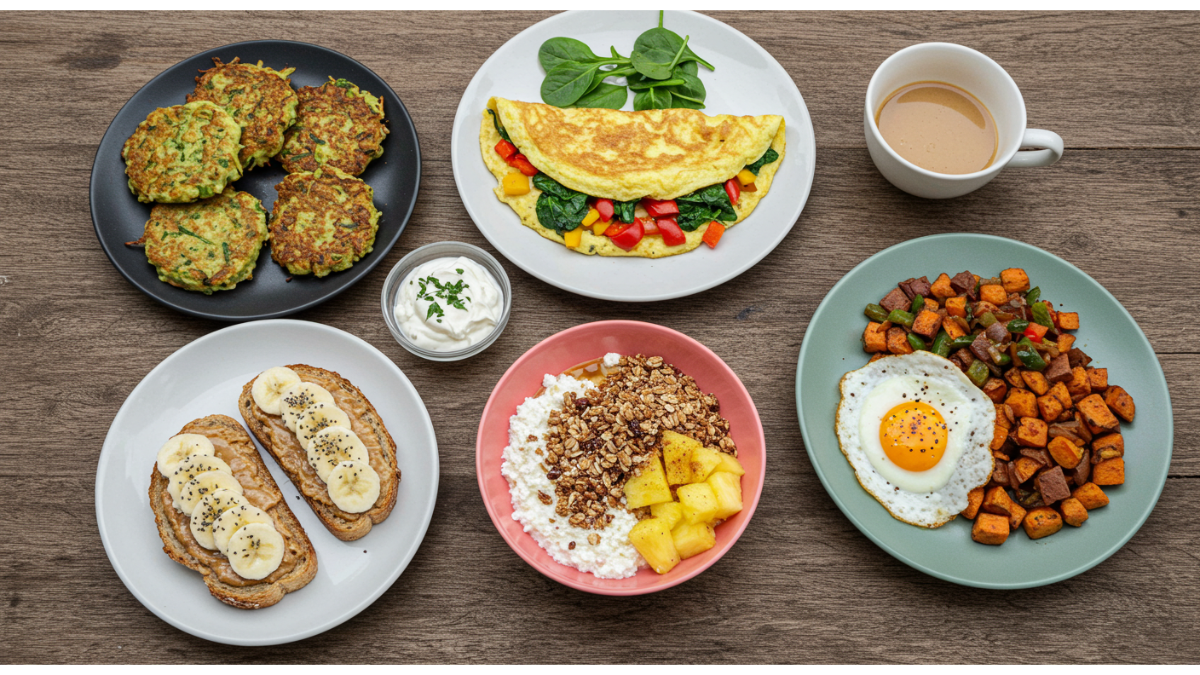
More Healthy recipes: https://recipesathomes.com/high-protein-low-carb-recipes/